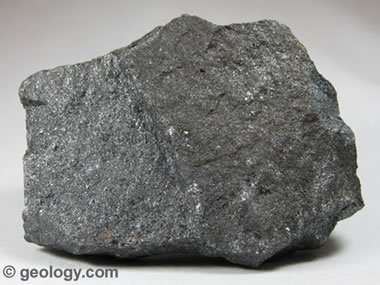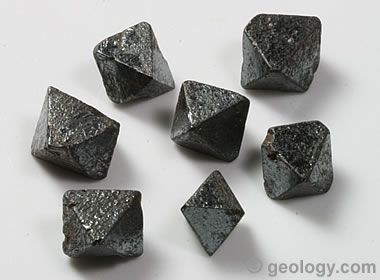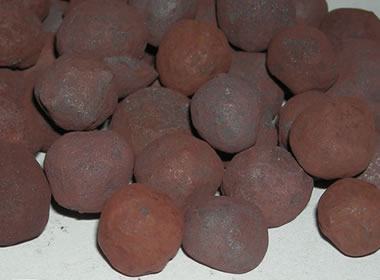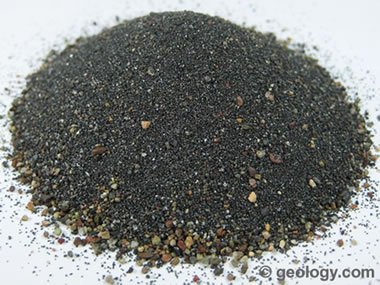Magnetite and Lodestone
The primary ore of iron, a mineral used in heavy media separation, and a recorder of Earth magnetism
Article by: Hobart M. King, PhD

Magnetite: A typical magnetite specimen exhibiting a gray metallic luster. This specimen is approximately 10 centimeters across.
What is Magnetite?
Magnetite is a very common iron oxide (Fe3O4) mineral that is found in igneous, metamorphic, and sedimentary rocks. It is the most commonly mined ore of iron. It is also the mineral with the highest iron content (72.4%).
Identification of Magnetite
Magnetite is very easy to identify. It is one of just a few minerals that are attracted to a common magnet. It is a black, opaque, submetallic to metallic mineral with a Mohs hardness between 5 and 6.5. It is often found in the form of isometric crystals. It is the most strongly magnetic mineral found in nature.
Pyrrhotite is the second most common magnetic mineral. It can easily be identified by its magnetic properties, lower hardness, and bronze color.

Lodestone: A specimen of lodestone that has attracted numerous tiny particles of iron. This specimen is approximately 10 centimeters across.

Magnetite Crystals: Octahedral crystals are a common crystal habit of magnetite. They are often seen in igneous and metamorphic rocks and sometimes seen in sediments near the magnetite source area. The magnetite crystals in this photo are about eight to twelve millimeters in maximum dimension.
Magnetite as "Lodestone"
Normal magnetite is attracted to a magnet, but some specimens are automagnetized and have the ability to attract small pieces of iron, small pieces of magnetite, and other magnetic objects. This form of magnetite, known as "lodestone," was man's first encounter with the property of magnetism. Lodestone is easily identified because it is usually covered with small particles of magnetite and other magnetic minerals (see photo).
Pieces of lodestone suspended on a string served as the first magnetic compasses and were used in China as early as 300 BC. When freely suspended on a string, a small piece of lodestone will align itself with Earth's magnetic field.
Physical Properties of Magnetite |
|
| Chemical Classification | Oxide |
| Color | Black to silvery gray |
| Streak | Black |
| Luster | Metallic to submetallic |
| Diaphaneity | Opaque |
| Cleavage | None |
| Mohs Hardness | 5 to 6.5 |
| Specific Gravity | 5.2 |
| Diagnostic Properties | Strongly magnetic, color, streak, octahedral crystal form. |
| Chemical Composition | Fe3O4 |
| Crystal System | Isometric |
| Uses | The most important ore of iron. Heavy media separation. Studies of Earth's magnetic field. |

Taconite pellets: These red spheres are taconite pellets that are ready to ship to a steel mill. The pellets are approximately 10 millimeters in diameter. Creative Commons photo by Harvey Henkelmann.
Use of Magnetite as an Ore of Iron
Most of the iron ore mined today is a banded sedimentary rock known as taconite that contains a mixture of magnetite, hematite, and chert. Once considered a waste material, taconite became an important ore after higher grade deposits were depleted. Today's commercial taconites contain 25 to 30% iron by weight.
At the mine site, the taconite ore is ground to a fine powder, and strong magnets are used to separate magnetically susceptible particles containing magnetite and hematite from the chert. The concentrate is then mixed with small amounts of limestone and clay, then rolled into small round pellets. These pellets are easy to handle and transport by ship, rail, or truck. They can be directly loaded into a blast furnace at a mill and be used to produce iron or steel.

The best way to learn about minerals is to study with a collection of small specimens that you can handle, examine, and observe their properties. Inexpensive mineral collections are available in the Geology.com Store. Image copyright iStockphoto / Anna Usova.
Use of Magnetite as a Heavy Media
Powdered magnetite is often mixed with a liquid to produce a thick, high-density slurry that is used for specific gravity separations. Much of the high-sulfur coal that is mined in the eastern United States is floated across a slurry of magnetite. Clean coal particles have a low specific gravity and float on the slurry. Particles contaminated with pyrite (a sulfide mineral with a high specific gravity) sink into the high-density slurry.

Magnetite sand: Some beach and river sands contain high concentrations of magnetite. Magnetite-rich "black sands" are commonly encountered by people panning for gold. Although magnetite sands and other heavy mineral accumulations are common, they are infrequently developed as mineral deposits because their size or grade is inadequate. The pile in the photo is approximately four inches (10 centimeters) across.
Use of Magnetite as an Abrasive
The abrasive known as "emery" is a natural mixture of magnetite and corundum. Some synthetic emery is produced by mixing magnetite with aluminum oxide particles. The production of synthetic emery gives the manufacturer control over the particle size and the relative abundance of aluminum oxide and magnetite in the product.
Some finely ground magnetite is also used as an abrasive in waterjet cutting. In the past few decades, synthetic abrasives have filled many of the applications where magnetite was previously used.
Other Uses of Magnetite
Small amounts of magnetite are also used as a toner in electrophotography, as a micronutrient in fertilizers, as a pigment in paints, and as an aggregate in high-density concrete.
Magnetite and Earth's Magnetic Field
Tiny crystals of magnetite are present in many rocks. In the crystallization of an igneous rock, tiny crystals of magnetite form in the melt, and because they are magnetic, they orient themselves with the direction and polarity of Earth's magnetic field. This preserves the orientation of Earth's magnetic field within the rock at the moment of crystallization.
Today, geologists can study the magnetic properties of rocks of various age and reconstruct the history of change in Earth's magnetic field. This information is available for multiple locations on multiple continents. It can also be used to learn about plate tectonics and the movement of continents over time.
A similar orientation of tiny magnetite grains occurs in the settling of sediment particles, locking clues to Earth's magnetic history into some sedimentary rocks.
| More Minerals |
 |
Herkimer Diamonds |
 |
The Acid Test |
 |
Tumbled Stones |
 |
Zircon |
 |
Fool*s Gold |
 |
Kyanite |
 |
Rock Tumblers |
 |
Rhodochrosite |

Find Other Topics on Geology.com:

|

| ||

|

| ||

|

| ||

|

|
